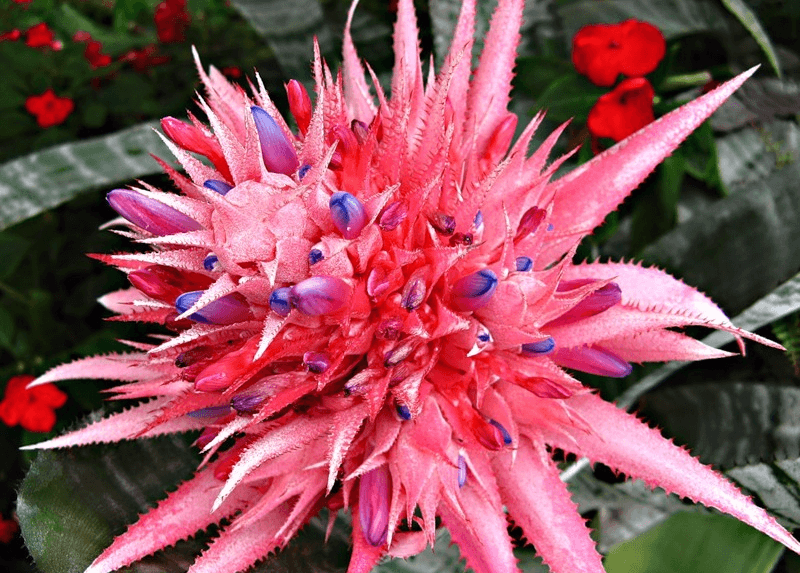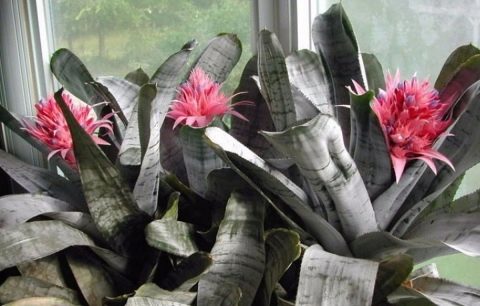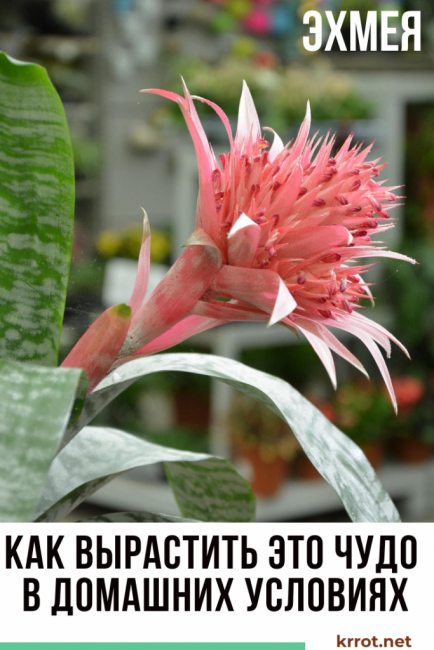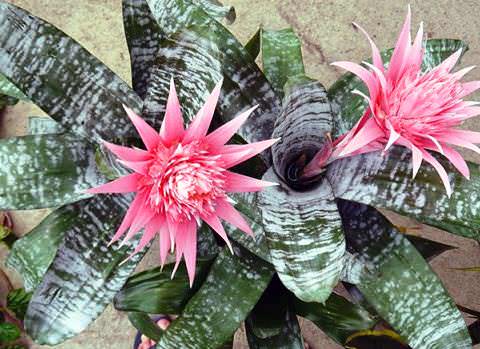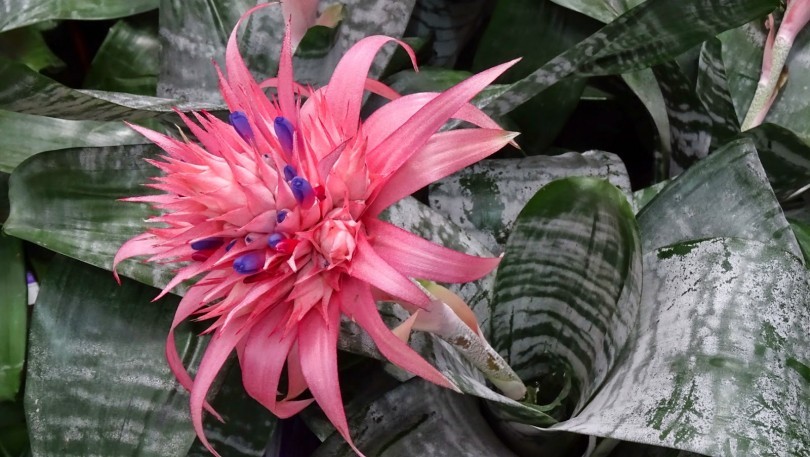What to do if the plant is attacked by pests - table
Ehmeya has good health, rarely gets sick, but insects can harm her: mealybug, scale insects, aphids.
| Pests | Signs of defeat | Fight and prevention |
| Shield | An adult pest is found under a brownish-gray shell. Located in the axils of the leaves. The larvae master the plant very quickly. | You can fight pests with the help of Aktara or Confidor. The rates for the preparation of the solution and the frequency of its use are indicated on the label. |
| Root worm | Due to damage to the root system, the plant stops growing. The leaves turn pale at first, then shrivel and dry out. |
|
| Mealybug | Small insects, covered with white cotton wool. With severe damage, the leaves turn yellow and die. | It is easy to deal with a lesion in a mild form: wipe the sheet with a damp cloth. For severe damage, spray the plant with a systemic insecticide weekly. |
| Aphid | Aphid colonies can destroy the plant by sucking the juices out of it. If measures are not taken in time, aphids can multiply very quickly. |
|
Photo gallery: how to recognize a pest

Scabbard feeds on plant juices

The root worm is difficult to detect at the initial stage

Mealybug infested plant

Small aphids can cause big trouble
Types and varieties of ehmei with photos and names
Ehmea Weilbach (Aechmea weilbachii)

Or Weilbach's lamprococcus (Lamprococcus weilbachii). The rosette is formed by flexible xiphoid leaf blades with a pointed end and a leathery surface. Small thornless thorns are located at the edge of each leaf. The color of the leaves is reddish green.
The size of the scaly peduncle can be up to half a meter, it is covered with small crimson foliage. The cluster inflorescence combines red bracts with lilac flowers, complemented by a white border. Sepals are partially accrete.
Ehmea two-row (Aechmea distichantha)

Or Platyaechmea distichantha. It happens both as an epiphyte and a terrestrial flower. Forms spreading rosettes up to a meter in diameter. Long foliage is pointed at the ends and green in color. There is a variegated variegata form with wide white stripes on its leaf blades. The size of each plate can reach up to half a meter with a width of about 3 cm. The edges of the leaves are framed by small closely spaced brownish thorns. The size of the peduncle reaches 60 cm. Purple flowers with bright red bracts bloom on it.
Ehmea curved (Aechmea recurvata)

The species can live both on the ground and in trees. Forms a rosette of linear foliage. Each rosette can contain about a dozen leaves about half a meter long. Their width does not exceed 1.5 cm, and at the base of the foliage grows together into a common tube. Spiny teeth are located along the edge of the leaves.
Flowering begins in spring. The size of the inflorescence of such an echmea reaches 20 cm. The red flowers have petals about 2.5 cm long, the bracts are also colored red.
This species has a miniature form of ortgiesii. The height of its rosette is only 15 cm. The foliage is leathery, "looking" upward. Its length reaches 30 cm. The flowers are pink in color, and the bracts are red.
Ehmea shaggy (Aechmea comata)

Or ehmea linden (Aechmea lindenii).It has foliage up to a meter long and 5 cm wide. The top of each sheet is rounded, and there are small teeth on the edge. In winter, Aechmea comata forms a spike inflorescence. It contains yellow flowers, complemented by red bracts. Has a Makoyana hybrid with creamy stripes on the leaf blades.
Echmea matte red (Aechmea miniata)

The socket includes a variety of sheet plates up to 50 cm long. The top of the foliage is pointed, and as it approaches the base, they become narrower. The color of the leaves is green, but at the bottom it takes on a dark purple hue. Tiny teeth are located along the edges of the sheet, and the surface has a scaly structure. Forms pyramidal inflorescences with blue flowers and red sepals. The berries that appear in their place are pink in color. The species is distinguished by a particularly long flowering and undemanding care.
Echmea striped (Aechmea fasciata)
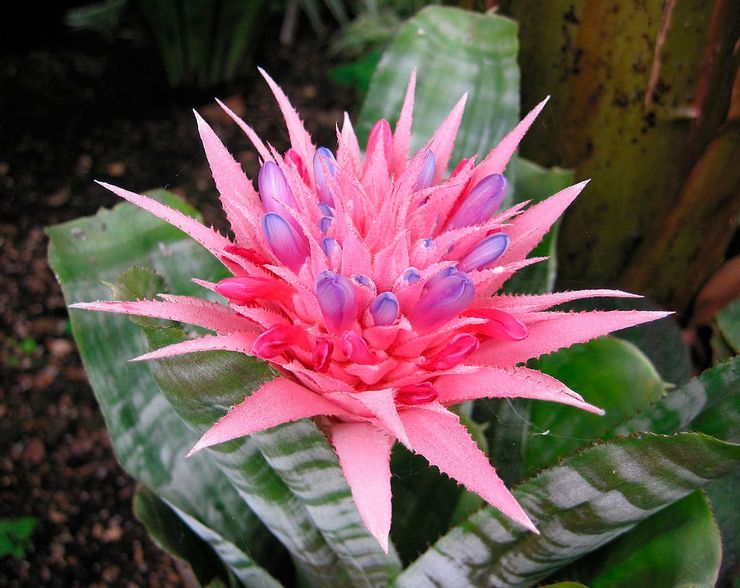
Or striped bilbergia (Billbergia fasciata). The socket forms a kind of tube. Its diameter reaches 1 m. Aechmea fasciata has belt-like leaf blades about 60 cm long and 6 cm wide. The color of the leaves is dark green, but against this background there is a marble pattern of light stripes. The peduncle is covered with small scales. The inflorescence is complex, about 30 cm long. The bracts are colored pink, and the flowers, as they develop, change their color from purple to reddish. Sepals are slightly pubescent. It has a hybrid form of Primera, characterized by a sharper and more contrasting pattern on the leaves.
Ehmea sparkling (Aechmea fulgens)

Forms a rosette of bright green belt-like foliage. Its length is slightly less than 50 cm. The leaves have a rounded top and a serrated edge. It blooms with coral flowers decorated with bracts. They are pink in color. Flowering is very abundant: one inflorescence can hold up to hundreds of flowers.
The view has the form discolor. It is notable for its two-colored foliage. From the inside, its plates are painted in red-purple color, and from the outside - in olive.
Echmea caudata

The foliage forming the rosette is directed straight. It is colored bright green and is complemented by a creamy yellow longitudinal stripe running along the edge of the leaf. Forms a panicle inflorescence, which includes golden-yellow flowers. The peduncle is covered with a light bloom.
Bromeliad Houseplants
Types of ehmea
Ehmeya is a tropical plant that has an impressive varietal variety. However, only the brightest representatives of bromeliads have moved to our homes. Popular types of overseas beauty are endowed with the following names:
- Ehmeya striped - half-meter leaf plates form a tubular rosette. The edges of the leaves are covered with sharp thorns. The medium-sized peduncle is covered with small plates. The color of the bracts is pink, and the flowers are blue, which changes to red closer to the tips.
- Echmeya sparkling (blue rhine) - the length of the leaf plates is 40 cm, the width is no more than 6 cm. The rounded ends of the belt-like leaves are covered with small thorns. The color of the deciduous rosette is green. Bracts are pink, flowers are coral-red with a blue top.
- Ehmeya bearded - leaf plates of rich green color are collected in an outlet. The leaves are framed with a beige stripe. The flowers are golden yellow. Ehmeya in the photo resembles a lush inverted broom in its shape. The surface of the long peduncle is covered with a whitish bloom.
Description

Homeland of an exotic flower - Central and South America
Ehmeya is a perennial herb from the Bromeliad family. This is an epiphyte, i.e. grows, attaching itself to the old trunk of trees, stumps. Rarely, but you can also find terrestrial species growing among stone or rocky hills.
The stem of the plant is short - no more than 50 cm in height. In its family, Ehmeya is distinguished by leaves. They are elongated, wide, rigid and with needles along the edges. Some species have soft, leathery foliage.In the central part, the green mass forms a kind of rosette with a funnel-shaped depression and in natural conditions it can reach up to 2 m in diameter.
The deciduous mass can vary from green to gray-green in color, and there are also striped deciduous plates.

Natural habitat
The plant has a poorly developed root system. Its main purpose is to keep its upper part on the reference object. It participates in nutritional work a little. This role is played by the leaves.
In appearance, the inflorescences are diverse: an ear, in the form of a head, a panicle. The color of the bracts is pink. They are shaped like lance tips. In their recesses there are flowers that come in red, blue, purple colors.
The flowering period lasts several months. Pollination of the inflorescence will contribute to the ripening of the fruit. These are small juicy berries containing a small oblong grain inside.
The rosette is capable of blooming only 1 time, and then dies. In addition to the main outlet, during its growth, additional shoots are formed on the sides, which in 3-4 years will also be able to please with their flowering.

Adenium at home: species, planting and care, plant diseases and pests. How to weave a pigtail and create a bright composition from different varieties? (60+ Photos)
External signs that cannot be ignored
The leaves take on a brown tint. This means that the plant is overflowing with water. It is necessary to free the outlet from the liquid and suspend watering. The same is the reaction of leaves to cold temperatures. You need to check if the flower is too cold. If the leaves have become soft, then watering is not enough, and you need to increase it. If dry tips appear on the leaves, the plant speaks of too dry air.
Improper care will not only aggravate the appearance, but can also contribute to the appearance of pests. The plant weakens and a favorable environment opens up for aphids and root worms, fungal and viral diseases.

Ehmeya striped contains poison in its leaves. It can irritate the skin of the hands. On contact with the eyes, a burning sensation will begin. To avoid these troubles, it is necessary to use rubber gloves when replanting and leaving. And after finishing work, wash your hands thoroughly with soap and water.
Ehmeya is a diamond among many indoor plants. It looks graceful in a single copy against the background of the interior. But it is simply impossible not to notice her beauty in the same row with her comrades-in-arms. Her gift is to bloom for a long time, this is a godsend for connoisseurs of beauty.
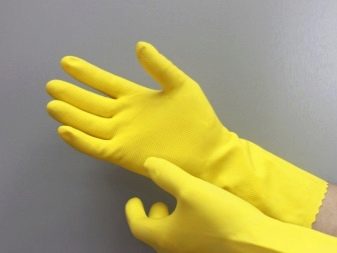

People are attracted by the exotic. Something unusual, not like everyone else, attracts florists. Ehmeya striped is an opportunity to enjoy flowering for a long period, while spending a minimum of effort to maintain the beauty of this royal plant.
You will learn more information about Ehmey striped in the video below.
Ehmey Weilbach and Luddemann


Ehmey Weilbach. Aechmea weilbachii. Epiphytic plant with a dense goblet leaf rosette. The leaves of this variety of echmea are 30-60 cm long, 2.5-3.5 cm wide, linear-xiphoid, with a short cusp, grooved, curved, narrowed towards the base, bright green, with rare thorns along the edge at the base. Peduncle up to 40-50 cm, straight, leaves on it are lanceolate-oval, thin, whole-edged, tiled, bright red. The inflorescence of Echmea Weilbach is a complex spreading brush 15 cm long, with a bright red axis and inflorescence leaves, glabrous. Spikelets are 2-6-flowered, friable, curved, up to 4 cm long. Bracts are rounded, with a slight acumen, equal in length to the ovary. Flowers up to 2.5 cm long, sessile, curved in the upper part. Sepals are pale lilac, accrete by a third. Petals are rounded, pale lilac, with a white edge, 2 cm long. Blooms in March - August, November. In culture since 1879. Homeland - the forests of Brazil. In floriculture practice known variety var. leodiensis with bronze leaves.

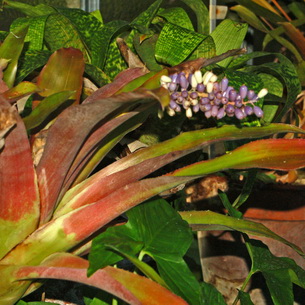
Ehmey Luddeman.Aechmea lueddeman. Epiphytic or terrestrial plant with a goblet leaf rosette. Leaves (there are about 20 of them) 30-60 cm long, 4.5 cm wide, lingual, pointed or rounded at the apex, turning into a sharp point, along the edges with curved thorns, covered with pale scales. Peduncle 25–70 cm, with a white powdery bloom, straight. The leaves on it are scarious, white, longer than internodes, whole-edged, the lower ones are erect, elliptical, the upper ones are bent, linear-lanceolate.
As you can see in the photo, this echmea has a broad-panicle inflorescence, cylindrical or narrow-pyramidal, 12-30 cm long:


The inflorescence twigs are simple or branched at the bottom, the brushes are few-flowered, loose. Bracts filiform, shorter than pedicels. Flowers rejected. Sepals are irregular in shape, with a wide lateral wing and a cusp, separate. The petals are ligulate, notched, pink or blue, becoming dark crimson when flowering. The fruits are bluish berries. Blooms in March-April. In culture since 1866. Homeland - Central America; grows on trees in forests or on rocky substrates at an altitude of 270-200 m above sea level.
Diseases and pests
Difficulties in growing echmea at home can arise from improper care or pest infestation. In most cases, diseases are caused by inadequate or excessive watering.
Possible plant diseases:
- Leaves dry out or turn brown. If the tips of the leaves change color, then this is a consequence of the low temperature in the room. A discoloration at the base of the leaf signals plant decay due to over-watering;
- Leaves wrinkle, droop, tips dry. The plant is deficient in moisture. This is caused by increased dryness of the air or occasional watering;
- Leaves turn yellow. The reason may be planting in the wrong substrate or pest infestation.

Signs of pest damage:
- Bromeliad shield. It settles on the upper and lower surfaces of leaves, as a result of which they turn yellow and then fall off.
- Red spider mite. It settles on the leaves, entwining them with its cobwebs. Subsequently, the leaves turn yellow and fall off.
- Aphids settle on the top of the leaves and suck the juice out of them. The leaves turn yellow and dry out.
- The mealybug also infects the leaves. The plant does not develop well, its growth slows down, the leaves turn yellow.
In case of damage by pests, it is necessary to treat the plant with appropriate preparations - insecticides. If, due to excessive watering or other reasons, the plant began to rot, only transplanting the echmea into a new substrate with appropriate treatment of the affected parts will help.
What is needed for planting ehmei
Ehmeya is a shallow rhizome plant, so it needs a wide pot with drainage holes. Its volume should be slightly larger than the volume of the root system. Ehmeya loves warmth and moisture, so it can be grown in a plastic pot.
The soil can be picked up at the store. It should be loose soil that allows water and air to pass through. You can make the substrate yourself using:
- chopped sphagnum;
- pine bark;
- coarse sand.
All components should be taken in equal amounts. Additionally, you can use horn shavings and peat for better structure.
Interesting! To avoid the appearance of mold, charcoal is added to the soil.
Step-by-step planting process:
- A thick drainage layer is laid at the bottom of the container.
- Soil is poured on top. They should fill the pot up to half.
- The leaves must be carefully collected at the base and the plant removed from the old container.
- The flower is lowered into the prepared pot, the rest of the earth is poured out on top.
- The transplanted plant should be placed in a place where the sun does not reach.
Attention! After transplanting ehmey, it is better not to water the first 3 days. This will speed up the period of her adaptation.
When and how it blooms
The beautiful ehmeya is loved by breeders because of its exotic flowering.On a massive peduncle, which, like an arrow, rises above the stem, spike-shaped or paniculate inflorescences are formed. Most often, the effect is created more by the bract than by the flowers themselves. The bracts are painted in bright red or pink colors, they can have serrations and are much larger than the flowers themselves.

Flowering of different species
Interesting fact! Flowering occurs in the fifth year of the indoor flower's life. Rooted daughter rosettes bloom in 2-3 years.
In its natural environment, the duration of flowering in echmea is up to 6 months in a row. At home, small flowers wither quickly. The bract lasts longer, on which the fruit and seed of the flower ripen.
Another feature of the unusual beauty is that the rosette blooms only once. And after flowering, it dies.
Types of ehmea with photos and names
Ehmea Weilbach (Aechmea weilbachii)

Or Weilbach's lamprococcus (Lamprococcus weilbachii). Linear-xiphoid soft leathery leaf plates are assembled into a rosette, their length is about half a meter, at the top they are sharpened, while the edge is covered with small thorns. They are colored greenish-red. The straight upward peduncle is about 50 centimeters long and is covered with many small crimson leaves. The complex inflorescence has the shape of a brush. The color of the bracts is deep red. The petals of the flowers are lilac-blue, and their edge is white, there are also sepals that have grown together by 1/3.
Ehmea two-row (Aechmea distichantha)

Or Platyaechmea distichantha. This species is represented by both epiphytes and terrestrial plants. A loose, spreading rosette of leaves reaches about 100 cm in diameter. Long narrow leaf plates in the upper part are pointed, they are colored green, their width is about 3 centimeters, and their length is up to 50 centimeters. On the edge are dark brown spines growing very close to each other. The height of the peduncle is more than 0.6 m. The color of the flowers is lilac, and the bracts are deep red. There is a variety - variegata: leaf plates are decorated with white stripes, which are located on the edge.
Ehmea curved (Aechmea recurvata)

Among the representatives of this species, there are both terrestrial plants and epiphytes. Linear leaf plates are assembled into an outlet, on one bush there are from 6 to 12 pieces. Their length is slightly less than 50 centimeters, while their width is about 15 mm, from top to bottom they grow together into a tube, the edge is covered with spikes 2 mm long. The capitate inflorescence reaches a height of only about 20 centimeters. The length of the petals of red flowers is about 25 mm, the bracts are also red. Such a plant blooms in spring.
This species has a variety of ortgiesii. The leaf rosette reaches a height of only 15 centimeters. Leathery leaf plates are directed upward at an angle. Their width is about one and a half centimeters, and their length is up to 30 centimeters, the edge is covered with small thorns. The color of the bracts is red, and the flowers are pink.
Ehmea shaggy (Aechmea comata)

Or ehmea linden (Aechmea lindenii). Belt-like sheet plates are about 5 centimeters wide and up to 100 centimeters long, they are assembled into a socket. Their upper part is spinous, but rounded, the edge is covered with small teeth. The shape of the inflorescence is spicate. The bracts in this species are red, and the flowers are rich yellow. Blooms in the winter.
Echmea matte red (Aechmea miniata)

A funnel-shaped rosette consists of a large number of leaf plates, the width of which is up to 2 centimeters, and the length is about half a meter. They are colored green, taper towards the base and have a lilac tint in this part, the upper part is shortly pointed. The edge of the foliage is covered with small teeth, and there are a few scales on its surface. The red straight peduncle is directed upwards. The apical inflorescence is pyramidal. The sepals are red and the flowers are bluish. Small fruits are colored deep pink.The flowering of such a plant is long.
Echmea striped (Aechmea fasciata)

Or striped bilbergia (Billbergia fasciata). The shape of the leaf rosette is tubular, in diameter it reaches about 100 cm.The length of the greenish-gray belt-like foliage is up to 0.6 meters, and its width is about 6 centimeters, on the surface there are transverse stripes of a marble-white hue. There are scales on the surface of a straight upwardly directed peduncle. The length of the complex pyramidal-capitate inflorescence is about 0.3 m, pink adherent leaves are present. The blue color of the flowers changes over time to reddish blue. There is pubescence on the surface of the sepals.
Ehmea sparkling (Aechmea fulgens)

The shape of the foliage collected in the outlet is belt-like, and its color is green. The width of the leaves is about 6 centimeters, and their length is slightly less than half a meter. Their top is rounded, and the edges are covered with denticles. The color of the flowers is coral red, and the bracts are pink. During flowering, up to 100 flowers are formed on the inflorescence.
The discolor variety is cultivated by flower growers: the color of the seamy surface of the foliage is reddish-purple, and the front is olive green.
Echmea caudata

Deep green leaf plates, collected in a rosette, are angled upward, they are decorated with a strip of creamy yellow that runs along the edge. On a long peduncle, a panicle-shaped inflorescence is formed, consisting of golden flowers.
Ehmeya is the most beautiful plant
Ehmeya: home care
The plant has taken root perfectly in the climate of Russian apartments, it is completely unpretentious in care. You won't have to make a greenhouse out of an apartment, but still, ehmeya will be glad to conditions close to her home.
In nature, the color of the exotic is much brighter and richer.
Temperature
The heat-loving ehmeya lives well in the summer on balconies or open verandas. Temperatures up to 26 ° C will be optimal in summer. During the cold season, it should be about 18 ° C. A drop in temperature to 15 ° C can be detrimental to the flower. This is especially true for varieties with bright foliage, such as striped ehmeya.
The resting period of the plant is not clearly expressed. During the whole winter period, Ehmeya is in a state of sleep. And all because there are no seasonal temperature drops in her homeland.
Interesting to know! Natural daily temperature drops provoke flowering.
Lighting
There should be a lot of light for ehmei. On a hot afternoon, you need to protect the leaves from direct sunlight. In summer, place on windowsills with an east or west direction. With the onset of cold weather, move to the south.
The bright color of variegated varieties of echmea maintains a sufficient amount of light
Watering
Proper watering of the plant is the key to its healthy growth and flowering. The higher the temperature, the more water exotics need.
Watering rules:
- With the onset of stable heat, watering should mimic tropical rainfall. You need to use a settled warm water, pouring it directly into the flower outlet and a little into the ground. The only difference from the conditions of wild growth is that excess water must be drained from the outlet after a while. Watering needs frequent, but without stagnation of water in the soil.
- With the onset of cold weather, watering is reduced and only the soil is watered. Watering into an outlet can provoke decay and the development of diseases.
- In winter, it is better to exclude watering altogether, replacing it with spraying.
Spraying
Ehmeya is an epiphyte, which means that its root system serves more as an attachment. And the exotic feeds on its long and wide leaves. Spraying is the main watering for ehmeya. In the autumn-winter months, spraying is reduced, but not completely excluded.
Humidity
Spraying daily creates moisture around the flower. In the summer heat, the pot is placed on a pallet with wet expanded clay or pebbles. Also, for the well-being of an exotic, it is necessary to regularly ventilate the room in which he lives.
Important! A bright beauty is afraid of drafts, which must be taken into account when airing
Priming
The beautiful ehmei has requirements for the soil - the earth should be light, airy and not retain water. Sod and leafy land in equal parts is the basis for the soil for ehmea. By ½ part of sand and humus, saturate and dilute this mixture. For greater airiness, add bark, pieces of charcoal, sphagnum moss.
Top dressing
Fertilization is also an important factor in growth and flowering. Throughout the summer period, every third watering should be with the addition of top dressing. Special baits for bromyel or potash fertilizers are suitable. Starting in autumn, it is better not to disturb the flower with unnecessary feeding. This can cause a lack of flowering and growth failure.
Is the flower poisonous or not
The plant's toxicity was attributed after an unfriendly meeting with its juice. This must be taken into account when caring for Ehmeya Striped at home. The juice of this particular variety can leave irritations and burns on the skin. Basic care, transplantation and reproduction should be carried out with the protection of the skin.
Flowering and resting period
An exotic species does not need a lot of time to relax. The dormant period is not always pronounced, in some varieties it is absent.
Echmea blooms in adult plants, not earlier than 4–5 years. First, a powerful, long peduncle appears, then bracts of bright color are formed
It is these elements that attract attention with rich colors and original form. The flowers themselves are not as showy as the parts around them.
Each bud does not stay on the peduncle for very long.
Low light is one of the factors that negatively affect the formation of buds. Most often, the problem occurs in varieties with variegated leaves. Only by adjusting the conditions of detention, moving the flowerpot with echmea to a bright room can we hope for the resumption of flowering.
Watering the soil and feeding ehmeya
Unlike many bromeliads, echmeas are relatively easy to care for. In spring and summer, watering ehmeya should be abundant. In summer, there should always be water in the funnel of leaves. In winter, watering is moderate. Top dressing with complex fertilizer should be carried out twice a month. To do this, use fertilizers made specifically for bromeliads. If at this frequency you apply fertilizer to the soil of a houseplant, the flower will always remain lush and fresh. Ehmeya needs feeding only in spring and summer, in winter and autumn there is no need to feed the plant.


It is important that watering is regular, you should not wait for the soil to dry out, the soil must always be wet
Description of ehmea and a photo of a houseplant at the time of flowering
Family: Bromeliads. The genus of Aechmea.
Natural climatic conditions: tropics and subtropics of Central and South America, Antilles.
In nature, there are about 170 species of echmea, about 10 are grown in culture. The most common are striped echmea, e. Walbach, e. flipped, eh. tailed, e. bracts and e. sparkling.
Ehmeya comes from South America, where it was discovered in 1826. The genus unites about 150 species native to Mexico, Argentina and Brazil. Epiphytic or terrestrial plants. These are almost stemless, medium-sized, herbaceous species, inhabitants of humid subtropics.
See how beautiful the echmea is at the time of flowering in these photos - amazingly structured inflorescences, depending on the species, have a variety of colors, they can be pink, coral, red-gold, red and blue:




Leaves in well-defined funnel-shaped rosettes are one-color or variegated, hard or soft-leathery, jagged along the edge. A thick peduncle with a spectacular inflorescence head at the end grows from the rosette. The stem is shortened. The shape of inflorescences and individual flowers is very diverse.
As you can see in the photo, in the indoor flower ehmeya, a characteristic decorative element of all types is bright pointed adherent leaves and bracts:


The fruit is a berry. Each rosette blooms only once, after flowering it dies off. The long, tough leaves are so tightly folded one after the other that they form a waterproof reservoir. The water accumulating in the funnels of the ehmea, over time, mixes with various forest debris, plant and animal debris falling from above. As a result, suspended marshes are formed on the trees, in which animals and plants settle.
Many representatives of the Ehmeya genus are beautiful ornamental plants that are widespread in culture. Ehmei are also popular because, unlike many bromeliads, they are relatively easy to care for.
The plant is used for landscaping rooms with windows of any orientation. If you know how to care for an ehmeya flower, you can use it for arrangements and compositions from plants in containers, on tree trunks, in hanging baskets; for winter gardens, window dressing. It is used singly for landscaping small spaces and in group compositions with other bromeliads.
Drying of the leaves and their brown tips indicate too dry air; if the air temperature is too low, parts of the plant may rot.






